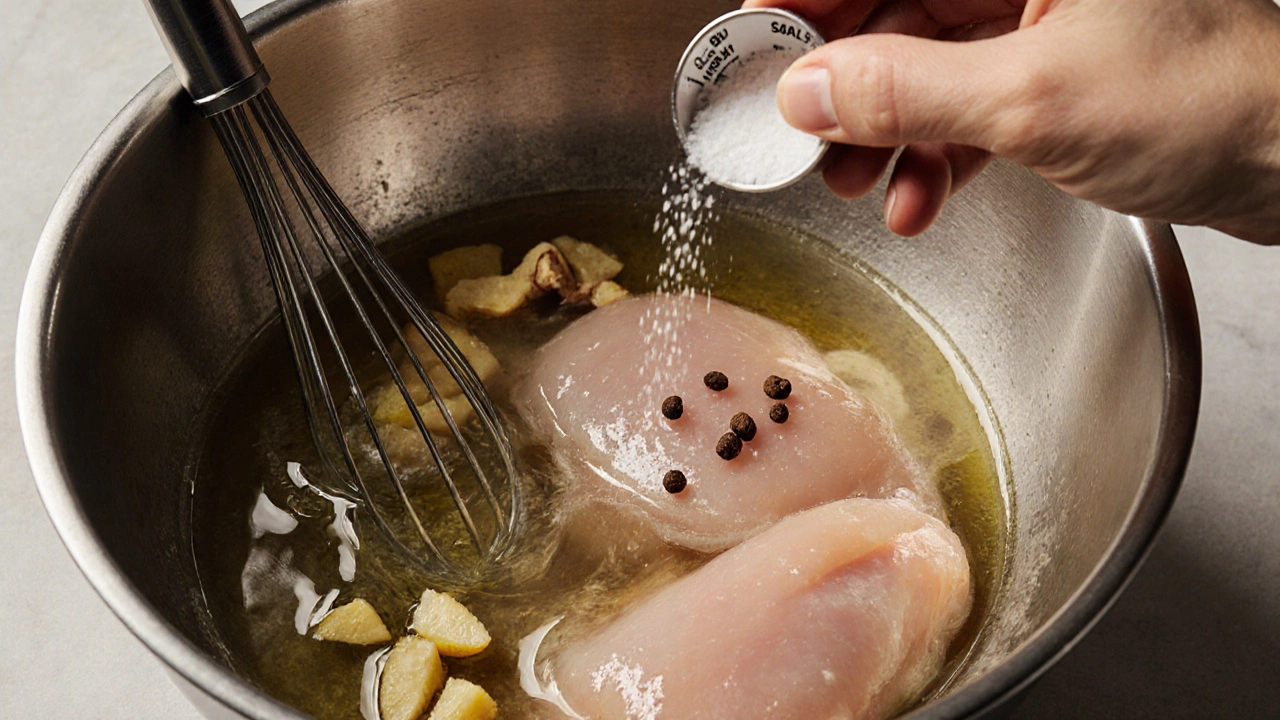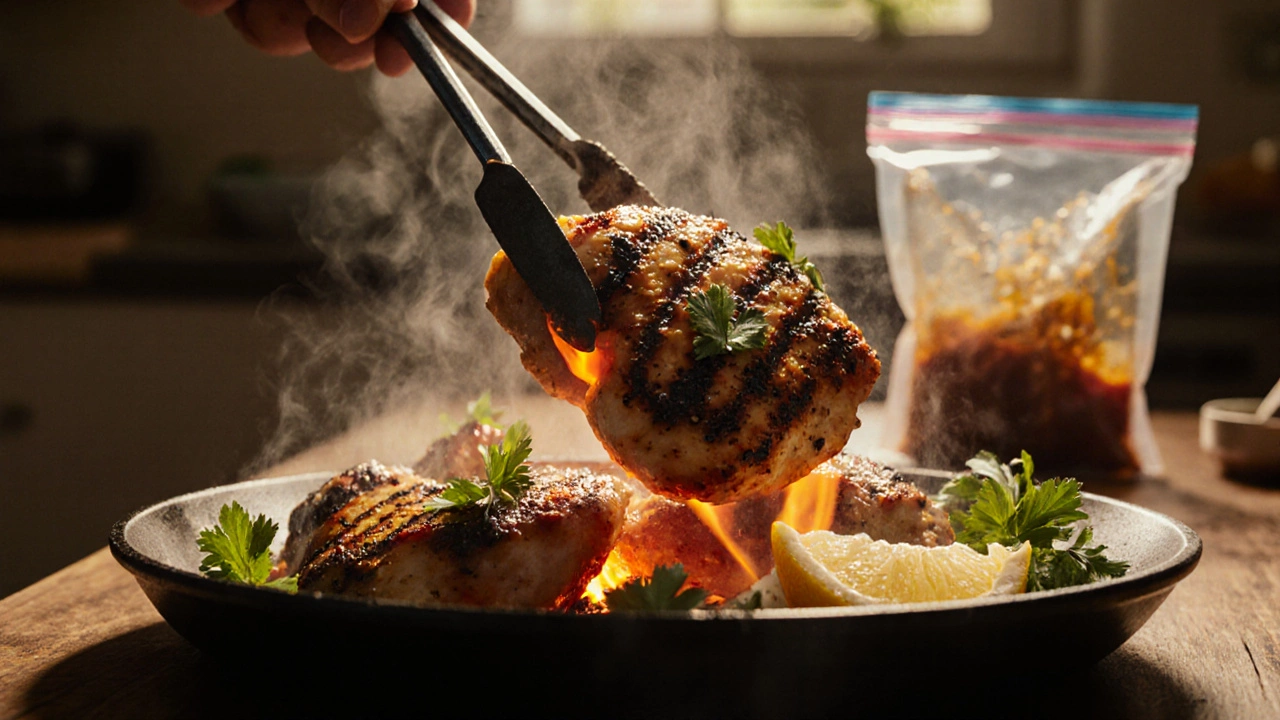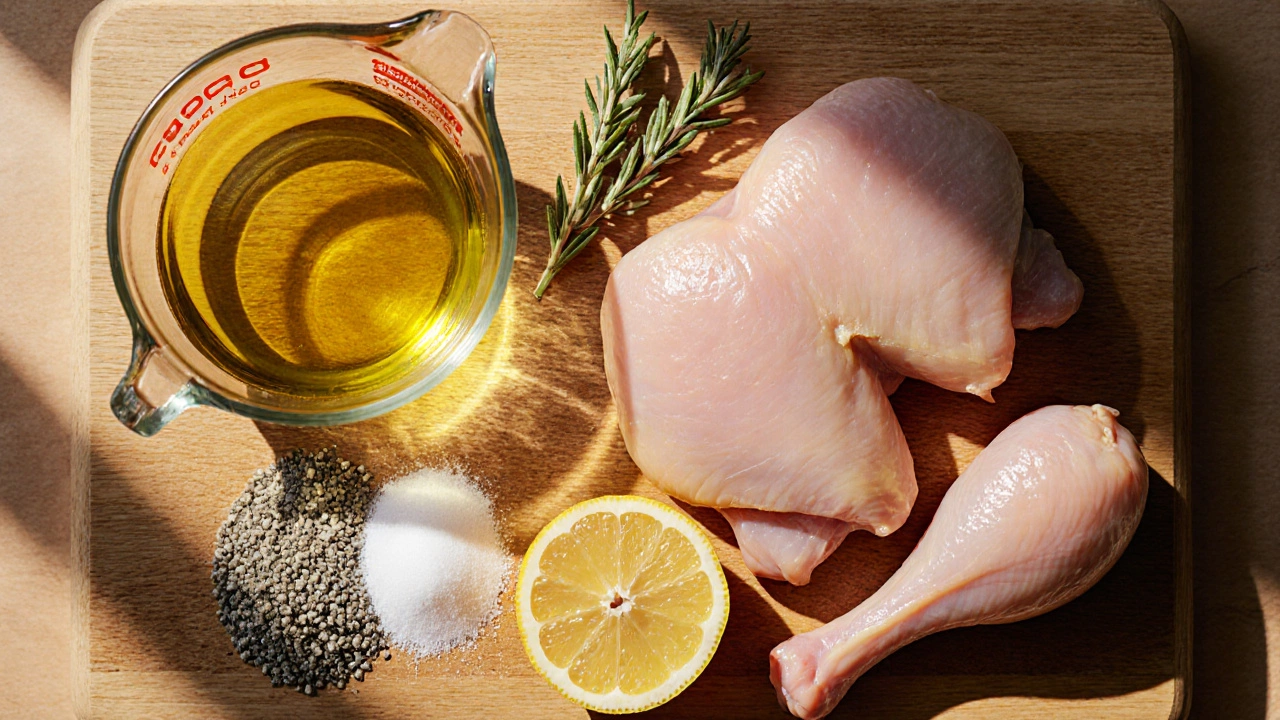Chicken Marinade Calculator
Quick Takeaways
Grab a few pantry staples, follow a 3‑2‑1 ratio, and you’ll have a basic chicken marinade that works for grilling, baking, or pan‑searing. Adjust the acid, oil, and seasonings to match the cuisine you crave, but keep the core balance and you’ll never miss the mark.
Understanding the Core Ratio
Every reliable chicken marinade starts with a simple math line:
- Salt (about 1‑2% of the chicken weight)
- Acid (citrus juice, vinegar, or yogurt - 1 part)
- Oil (neutral oil - 2 parts)
Think of it as 1cup acid to 2cups oil, then sprinkle in the proper amount of salt. This 3‑2‑1 foundation ensures the chicken stays juicy, the flavors penetrate, and the surface doesn’t dry out during cooking.

Building the Marinade: Step‑by‑Step
- Measure your chicken weight. For a typical family dinner, 1kg (2.2lb) of bone‑in pieces works well.
- Calculate salt: 10‑20g (≈½‑¾tsp). Sprinkle over the meat and let it sit for 10minutes - this starts the dry‑brine.
- In a bowl, combine the Acid (e.g., ¼cup lemon juice) with Oil (½cup olive or canola oil). Whisk until blended.
- Add flavor boosters:
- Garlic (2 cloves, minced)
- Ginger (1 tsp grated, optional)
- Herbs (fresh thyme, rosemary, or cilantro - 1‑2 tbsp)
- Spices (black pepper, paprika, cumin - ½‑1 tsp each)
- Sweetener (honey or brown sugar - 1 tsp for balance)
- Pour the liquid mixture over the salted chicken, toss to coat, and transfer everything to a zip‑lock bag or non‑reactive bowl.
- Refrigerate for 30minutes up to 12hours, depending on how deep you want the flavor.
- 30min → light surface flavor.
- 2‑4hr → balanced penetration.
- 8‑12hr → deep, aromatic profile (ideal for grilling).
Flavor Variations & When to Swap Ingredients
Once you’ve mastered the core ratio, swapping a single element can give you an entirely new vibe.
| Acid | Acidity Level (pH) | Flavor Profile | Best Use |
|---|---|---|---|
| Fresh Lemon Juice | 2.2 | Citrusy, bright | Grill, Mediterranean dishes |
| Apple Cider Vinegar | 2.9 | Tangy, slightly sweet | Baked chicken, BBQ sauces |
| Plain Yogurt | 4.5 | Creamy, mild | Indian tandoori, Middle‑Eastern shawarma |
| Rice Wine (Mirin) | 3.0 | Sweet‑savory, umami | Asian stir‑fry, teriyaki glaze |
Swap the oil too: extra‑virgin olive oil adds fruitiness, while neutral oils (canola, grapeseed) let the spices shine. For a richer mouthfeel, blend ¼cup melted butter into the oil portion just before cooking.
How to Marinate Properly
- Container choice: glass or food‑grade plastic; avoid reactive metal that can alter flavor.
- Temperature: always keep the chicken at ≤4°C (40°F). If you need a quick marinate, use a shallow dish and refrigerate in a single layer.
- Timing: bone‑in pieces benefit from longer marinades; boneless breasts can over‑tenderize after 6hours because the acid breaks down proteins.
- Dry‑after‑marinade: pat the chicken dry before searing to get a nice crust; excess moisture will steam instead of brown.
- Reuse caution: never reuse a used marinade as a sauce unless you boil it for at least 3minutes to kill any bacteria.

Troubleshooting Common Issues
Even a solid formula can go sideways if you miss a step.
| Problem | Cause | Fix |
|---|---|---|
| Chicken tastes flat | Not enough salt or acid | Increase salt to 1.5% of weight; add a splash more lemon juice. |
| Meat is mushy | Marinated >12hr with strong acid | Cut time in half or switch to milder acid like yogurt. |
| Skin doesn’t crisp | Too much liquid on surface | Pat dry, then coat with a thin layer of oil right before cooking. |
| Burnt edges | High sugar content + high heat | Reduce honey/brown sugar or lower grill temperature. |
Basic Marinade Checklist
- 📏 Measure chicken weight.
- 🧂 Weigh salt (10‑20g per kg).
- 🍋 Choose an acid (lemon, vinegar, yogurt).
- 🛢️ Pick a neutral or flavored oil.
- 🌿 Gather herbs, spices, aromatics, and optional sweetener.
- ⏰ Set a timer for the desired marinating period.
- ❄️ Store in the fridge, not on the counter.
Frequently Asked Questions
Can I use this formula for turkey or pork?
Absolutely. The 3‑2‑1 ratio works for most lean meats. Adjust the salt slightly for larger cuts (1‑2% of weight) and extend marinating time for tougher muscle fibers.
Is it safe to marinate chicken at room temperature?
No. Bacteria multiply quickly in the danger zone (40‑140°F). Always keep the bag or container in the refrigerator, even if you’re only marinating for 30minutes.
Should I add salt before or after the acid?
Salt works best as a dry brine first. Sprinkle it on the raw chicken, let it sit for a few minutes, then add the liquid components. This prevents the acid from drawing out excess moisture too early.
Can I freeze a marinated chicken batch?
Yes. After mixing, place the chicken and its marinade in a freezer‑safe bag. Thaw overnight in the fridge before cooking. Freezing can actually help the flavors meld.
Why does my chicken stay pale after marinating?
A light color usually means the acid was mild (yogurt or a small amount of lemon). If you want a deeper hue, add a pinch of smoked paprika or a splash of soy sauce.
With the 3‑2‑1 backbone and a few tweaks, you can spin up a new chicken flavor every night. Grab the ingredients, set a timer, and enjoy the juicy results.
